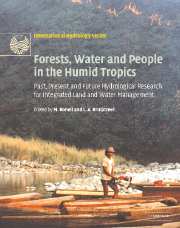 Forests, Water and People in the Humid Tropics
Forests, Water and People in the Humid Tropics Book contents
- Frontmatter
- Contents
- List of contributors
- Foreword
- Preface
- Acknowledgements
- Symposium and Workshop
- Introduction
- Part I Current trends and perspectives on people–land use–water issues
- Part II Hydrological processes in undisturbed forests
- Part III Forest disturbance, conversion and recovery
- Part IV New methods for evaluating effects of land-use change
- Part V Critical appraisals of best management practices
- Conclusion: Forests, water and people in the humid tropics: an emerging view
- Plate section
Part III - Forest disturbance, conversion and recovery
Published online by Cambridge University Press: 12 January 2010
- Frontmatter
- Contents
- List of contributors
- Foreword
- Preface
- Acknowledgements
- Symposium and Workshop
- Introduction
- Part I Current trends and perspectives on people–land use–water issues
- Part II Hydrological processes in undisturbed forests
- Part III Forest disturbance, conversion and recovery
- Part IV New methods for evaluating effects of land-use change
- Part V Critical appraisals of best management practices
- Conclusion: Forests, water and people in the humid tropics: an emerging view
- Plate section
Summary
SUMMARY
This part contains eight chapters, the first three of which deal with the soil and water impacts of various kinds of forest disturbances, in order of increasing intensity. These are then followed by two chapters discussing the impacts of forest clearing and burning for the establishment of other land uses (pasture, cropping, plantations) at the small catchment, and river basin scale, respectively. The final three chapters focus on the changes in hydrology and soil nutrient reserves associated with forest regeneration, tree planting and the mixed crop-tree systems collectively known as agroforestry.
It is commonly overlooked that humid tropical forests are subject to a range of natural disturbances, including treefalls, landslides, hurricanes, floods, droughts, fires, volcanic eruptions, earthquakes and, in coastal areas, tsunamis. With the exception of treefalls and landslides, all of these have a significant impact on hydrological functioning and nutrient cycling at the catchment scale, with the geomorphology of an area often affected too. Scatena, Planos-Gutierrez and Schellekens provide an overview of the hydrological impacts of the principal natural disturbances occurring in humid tropical forest, emphasising that most forests experience disturbance-generating rainfalls at least once every decade. Rainfalls of c.200 mm day-;1 may cause treefall gaps, landslides (especially in steep, tectonically-active areas) and localised flooding. Events in the order of 400–500 mm of rain day-;1 (commonly associated with hurricanes) can cause widespread landscape modification, mainly through landsliding.
- Type
- Chapter
- Information
- Forests, Water and People in the Humid TropicsPast, Present and Future Hydrological Research for Integrated Land and Water Management, pp. 485 - 488Publisher: Cambridge University PressPrint publication year: 2005


